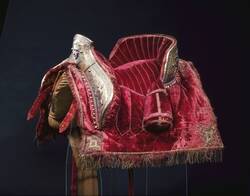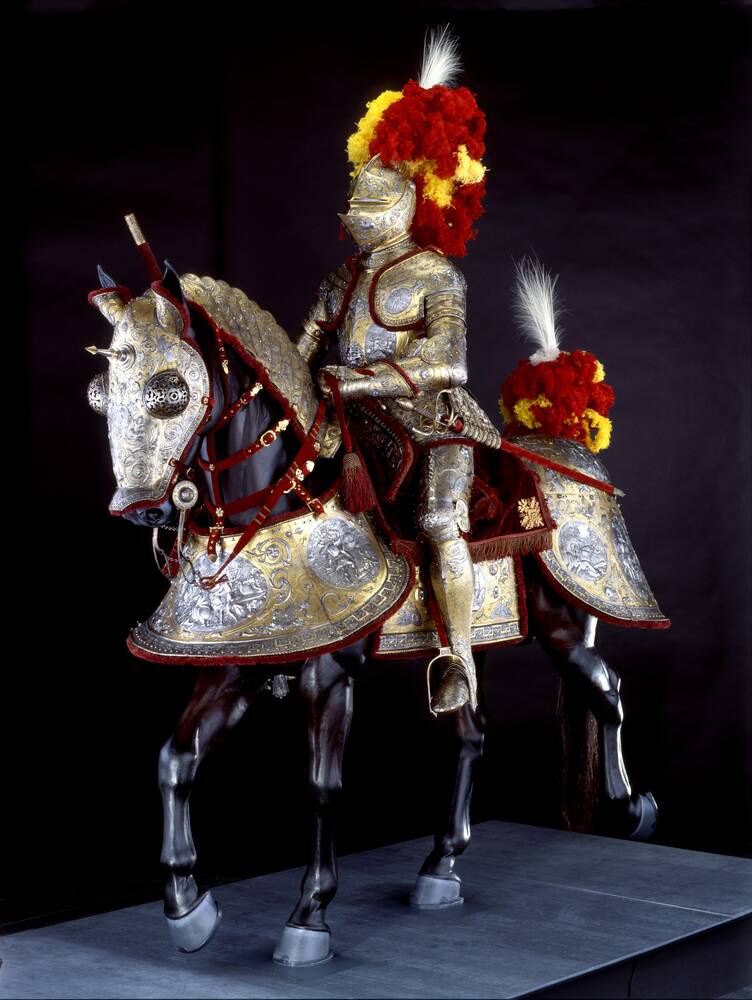Elector Christian II purchased a second ceremonial armour with decorations by Eliseus Libaerts from Heinrich Cnoep – this time it was not for his brother but for himself. That was in 1606. And once again he selected a masterpiece of ornamentation by the Antwerp goldsmith for King Erik XIV of Sweden between 1563 and 1565.
Libaerts had sent samples of chanfrons to Stockholm, and both the motifs and the main colour of the design were agreed upon in an exchange of letters. This then prompted the Swedish king to commission his own royal armourers to produce a made-to-measure suit of armour for himself, which was then decorated by Libaerts.
This set comprises a suit of armour with a Burgundy helmet and a complete harness for the knight’s charger. The knight and his mount are arrayed in the same style so that their overall appearance is one of elegant splendour. The entire surface is covered with embossed and etched decoration. There’s no spot left untouched, yet the ornamentation doesn’t look overdone. The gold background and polished embossed designs are so harmonious that there is no sense of confusion – no imbalance. The horse’s harness consists of a full chanfron, to protect the horse’s head, with meshed eye-guards and a head spike. The concave front of the horse’s armour was called the peytral; the rear section was called the cruppe.
Christian II paid 8,800 guilders for this splendid armour and it was paraded as the “joyful armour” at his funeral – in keeping with the same tradition that had been practised at his father’s burial. More than a century later, in 1719, it was put on show once again. August the Strong displayed it in his great exhibition of weapons on the occasion of his son’s wedding. With its prestige as chivalrous armour and its decorative programme alluding to the classical legend of Hercules, this set of armour is emblematic of the Early Modern cult of the powerful leader. It is no coincidence that August the Strong encouraged the image of himself as “Hercules Saxonicus” – the Hercules of Saxony.
If you would like to find out more, please listen to the audio under further media.
Further Media
Decorating armour with foliage and abstract patterns was one way of enhancing it, in fact, the most common. By contrast, coats of arms and allegorical scenes were exclusively reserved for the highest-ranking princes and warriors, and were interpreted by those who wore them and everyone who saw them in political terms. The Hercules Armour, made by Eliseus Libaerts for the King of Sweden, has more than one hundred scenes and motifs drawn from classical mythology. This ceremonial armour for horse and rider is the Dresden Armoury’s crowning glory. It is decorated with an all-over foliage pattern, pierced by twenty-one large pictorial medallions depicting the heroic deeds of Hercules and Theseus as well as scenes from the Trojan War and the myth of Jason and the Argonauts.
Hercules was popular with European rulers in the Renaissance and Baroque eras. Being associated with him reflected their own claims to power and greatness. At the tender age of eight months, Hercules had demonstrated superhuman strength and presence of mind in his cot by strangling two of the serpents sent by the jealous goddess Juno. After performing numerous heroic deeds, he ascended to Olympus, the home of the gods – and European princes and kings wanted posterity to at least deem them worthy of similar honours.
The central motif of the banding, directly beneath the horse’s head, is the War of the Centaurs, known as the Centauromachy. Hercules‘s struggle with the wild and drunken centaurs is not in fact one of his famous twelve heroic deeds, but may perhaps be interpreted as an allusion to the Swedish king’s marriage plans. According to legend, the conflict took place during a wedding.
King Peirithous was the King of the Lapiths in Thessaly, and had chosen Hippodameia to be his bride. At their wedding, to which he had invited the Centaurs, a quarrel broke out, and one of the Centaurs, Eurytion, abducted the bride. The infuriated host had Eurytion’s ears and nose cut off. Hercules took part in the ensuing battle and helped to defeat the Centaurs.
On the medallion we see Hercules beating an already stumbling Centaur with his raised club. These mythical creatures – half-human and half-horse – were regarded by the ancient Greeks as unruly and lecherous. Here, they appear to be in the majority. Evidently, the issue is no longer just the abduction of the bride. We see several women being seized and carried off by the Centaurs.
The charger’s armour was made in Antwerp or in another European workshop under Libaert’s direction. This is confirmed by several sources. The cost of the materials and workmanship was enormous. Libaerts was almost penniless by the time he had completed the commission, and he was only to receive payment on delivery. That is probably why he set out with his brother, Natal, to deliver the armour in person.

